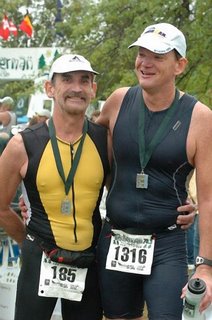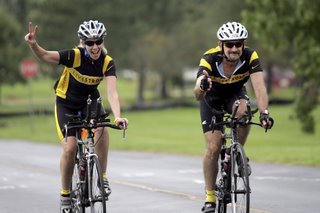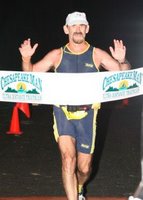Fascination with Numbers ... Continued
If you've read this blog before you will know that I have an unhealthy fascination with numbers. Yes, my training log on the computer has every workout since 1992 fully totaled and graphed. So it was with glee that I got my new GARMIN 305 to make sure I was really running 20 miles and not 19.5 (and overestimating my true speed). Based upon my long runs (which turned out to be not quite so long) and long bike rides, the little device seemed uncannily accurate except for one situation.
Once a week I hit the Phoenixville High School track for some sort of torture (like Yasso 800s or 3 x 3M @ Tempo). I follow the rule that says to alternate track directions to lessen the pressure on the knees. Over the last two months with this device it has been strangely consistent. It always said I ran shorter when I ran counter-clockwise (normal track direction) than when I ran clockwise. After a while I learned to subtract 10 seconds from the pace when going in the seemingly shorter direction (Confused yet?).
Yesterday, while running away from a pack of mostly overweight middle-school students it hit me. Duh! My watch was on my LEFT hand. When I ran counter-clockwise it was traveling a shorter distance then my RIGHT hand. When I ran clockwise the watch is on the outside (closer to lane 2) and was then traveling a longer distance. I laughed at myself and said that couldn't make up for the 2-3 % difference in distances that I consistently found.
Then I did the math ...
Making simple assumptions (equal quadrant track) gives the curve on the track a radius of 31.8 meters. If I simply add ONE meter to the radius (about the width of a lane), the total distance around the track turned out to be 406 meters, about 1.5% more. Even adding about two feet (distance apart hands are when running) there was a clear 1% difference. The straightaways are the same so there was a big chunk of the difference I saw. The other part could be easily explained (though I wasn't going there) by the fact that watch checks its position once a second and it would cut the radius into little chords a bit shorter than I would get if the measurement was continuous (remember your calculus with epsilon and delta?). I had noticed that the slower I ran the closer the GARMIN said I traveled the 400M around.
Moral of the story: RUN THE TANGENTS






